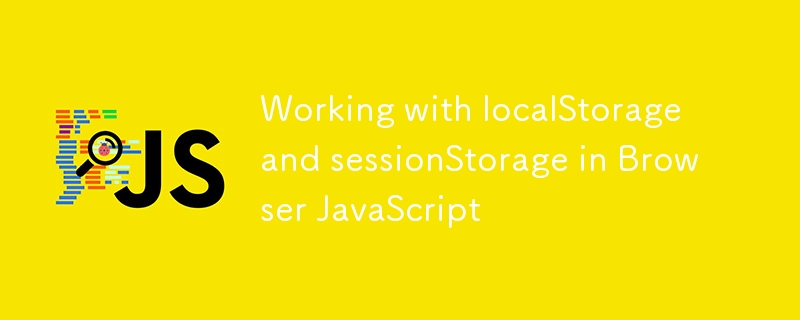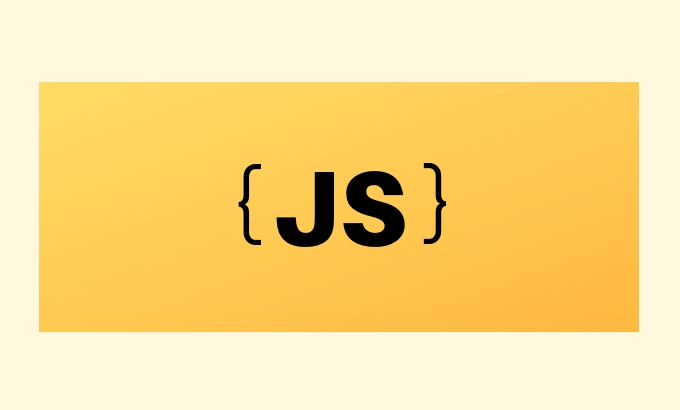Working with localStorage and sessionStorage in Browser JavaScript
Jul 09, 2025 am 02:27 AMlocalStorage is used to store data for a long time, and the data is not lost after closing the browser; sessionStorage is used to store during the session and clear after closing the page. Both operate string data through setItem, getItem, etc., and the stored object needs to be converted using JSON.stringify. 1. localStorage is suitable for user settings, long-term caching, and login status maintenance; 2. sessionStorage is suitable for temporary communication, current session cache, and sensitive information storage. Pay attention to avoid misuse of localStorage to store sensitive information, pay attention to storage size limitations, same-origin policies, complex data update mechanisms and cross-label synchronization issues.

The browser's JavaScript provides two APIs: localStorage and sessionStorage , which are used to store data on the client side. The difference is the life cycle of the data: localStorage is permanently saved until manually cleared, while sessionStorage is only valid during the current session and will be cleared after closing the page or tab.

These two tools are very useful if you need to persist some user settings, cache content, or pass data across pages. Let’s talk about how to use them well from the perspective of actual use.

Basic usage: add, delete, modify and check
Whether it is localStorage or sessionStorage , the basic operation method is the same:
- Store data:
setItem(key, value) - Get data:
getItem(key) - Delete data:
removeItem(key) - Clear all:
clear() - Get all keys:
key(index)
For example:

// Store localStorage.setItem('theme', 'dark'); sessionStorage.setItem('token', 'abc123'); // Read const theme = localStorage.getItem('theme'); // 'dark' // Delete localStorage.removeItem('theme'); // Clear sessionStorage.clear();
Note that these methods can only store strings. If you want to save an object or an array, you need to convert it with JSON.stringify() and then save it. When reading it, then JSON.parse() it back.
Comparison and suggestions for use scenarios
Although the APIs of the two are the same, the applicable scenarios are different:
localStorage :
- User preferences (such as topics, languages)
- Long-term cache of data (such as history)
- Login status remains (combined with token)
sessionStorage :
- Temporary communication between pages (such as multi-step form)
- Data cache for the current session (don't want cross-page pollution)
- Sensitive information (such as one-time tokens) and do not want to stay in the browser for a long time
A common misuse is to store sensitive data in localStorage , and forget to clean it up, which can easily lead to leakage. If you only need one-time data sharing, it is recommended to use sessionStorage .
Notes and FAQs
Although it is easy to use, some details are easy to get stuck:
- Data size limit: Usually each source has a maximum of about 5MB, and an error will be reported if it exceeds it.
- Same-origin policy restrictions: Only access storage under the same protocol, domain name, and port.
- It does not support listening for complex data changes: when modifying an object, you must write it back in the entire process.
- Synchronous updates between multiple tabs require listening to events.
For example, if you change the localStorage value on one tab, another tab can respond to changes by listening to storage events:
window.addEventListener('storage', (event) => {
if (event.key === 'theme') {
console.log('Theme has been changed to:', event.newValue);
}
});However, this event will not be triggered on the current page, and will only take effect in other open same-origin pages.
Basically that's it. By mastering these points, you can use local storage reasonably in the project. The key is to distinguish when to use localStorage , when to use sessionStorage , and to handle the data format and boundary situations.
The above is the detailed content of Working with localStorage and sessionStorage in Browser JavaScript. For more information, please follow other related articles on the PHP Chinese website!

Hot AI Tools

Undress AI Tool
Undress images for free

Undresser.AI Undress
AI-powered app for creating realistic nude photos

AI Clothes Remover
Online AI tool for removing clothes from photos.

Clothoff.io
AI clothes remover

Video Face Swap
Swap faces in any video effortlessly with our completely free AI face swap tool!

Hot Article

Hot Tools

Notepad++7.3.1
Easy-to-use and free code editor

SublimeText3 Chinese version
Chinese version, very easy to use

Zend Studio 13.0.1
Powerful PHP integrated development environment

Dreamweaver CS6
Visual web development tools

SublimeText3 Mac version
God-level code editing software (SublimeText3)

Hot Topics
 JavaScript vs. Java: Which Language Should You Learn?
Jun 10, 2025 am 12:05 AM
JavaScript vs. Java: Which Language Should You Learn?
Jun 10, 2025 am 12:05 AM
JavaScriptisidealforwebdevelopment,whileJavasuitslarge-scaleapplicationsandAndroiddevelopment.1)JavaScriptexcelsincreatinginteractivewebexperiencesandfull-stackdevelopmentwithNode.js.2)Javaisrobustforenterprisesoftwareandbackendsystems,offeringstrong
 Which Comment Symbols to Use in JavaScript: A Clear Explanation
Jun 12, 2025 am 10:27 AM
Which Comment Symbols to Use in JavaScript: A Clear Explanation
Jun 12, 2025 am 10:27 AM
In JavaScript, choosing a single-line comment (//) or a multi-line comment (//) depends on the purpose and project requirements of the comment: 1. Use single-line comments for quick and inline interpretation; 2. Use multi-line comments for detailed documentation; 3. Maintain the consistency of the comment style; 4. Avoid over-annotation; 5. Ensure that the comments are updated synchronously with the code. Choosing the right annotation style can help improve the readability and maintainability of your code.
 The Ultimate Guide to JavaScript Comments: Enhance Code Clarity
Jun 11, 2025 am 12:04 AM
The Ultimate Guide to JavaScript Comments: Enhance Code Clarity
Jun 11, 2025 am 12:04 AM
Yes,JavaScriptcommentsarenecessaryandshouldbeusedeffectively.1)Theyguidedevelopersthroughcodelogicandintent,2)arevitalincomplexprojects,and3)shouldenhanceclaritywithoutclutteringthecode.
 Javascript Comments: short explanation
Jun 19, 2025 am 12:40 AM
Javascript Comments: short explanation
Jun 19, 2025 am 12:40 AM
JavaScriptcommentsareessentialformaintaining,reading,andguidingcodeexecution.1)Single-linecommentsareusedforquickexplanations.2)Multi-linecommentsexplaincomplexlogicorprovidedetaileddocumentation.3)Inlinecommentsclarifyspecificpartsofcode.Bestpractic
 Java vs. JavaScript: Clearing Up the Confusion
Jun 20, 2025 am 12:27 AM
Java vs. JavaScript: Clearing Up the Confusion
Jun 20, 2025 am 12:27 AM
Java and JavaScript are different programming languages, each suitable for different application scenarios. Java is used for large enterprise and mobile application development, while JavaScript is mainly used for web page development.
 Mastering JavaScript Comments: A Comprehensive Guide
Jun 14, 2025 am 12:11 AM
Mastering JavaScript Comments: A Comprehensive Guide
Jun 14, 2025 am 12:11 AM
CommentsarecrucialinJavaScriptformaintainingclarityandfosteringcollaboration.1)Theyhelpindebugging,onboarding,andunderstandingcodeevolution.2)Usesingle-linecommentsforquickexplanationsandmulti-linecommentsfordetaileddescriptions.3)Bestpracticesinclud
 JavaScript Data Types: A Deep Dive
Jun 13, 2025 am 12:10 AM
JavaScript Data Types: A Deep Dive
Jun 13, 2025 am 12:10 AM
JavaScripthasseveralprimitivedatatypes:Number,String,Boolean,Undefined,Null,Symbol,andBigInt,andnon-primitivetypeslikeObjectandArray.Understandingtheseiscrucialforwritingefficient,bug-freecode:1)Numberusesa64-bitformat,leadingtofloating-pointissuesli
 JavaScript: Exploring Data Types for Efficient Coding
Jun 20, 2025 am 12:46 AM
JavaScript: Exploring Data Types for Efficient Coding
Jun 20, 2025 am 12:46 AM
JavaScripthassevenfundamentaldatatypes:number,string,boolean,undefined,null,object,andsymbol.1)Numbersuseadouble-precisionformat,usefulforwidevaluerangesbutbecautiouswithfloating-pointarithmetic.2)Stringsareimmutable,useefficientconcatenationmethodsf






